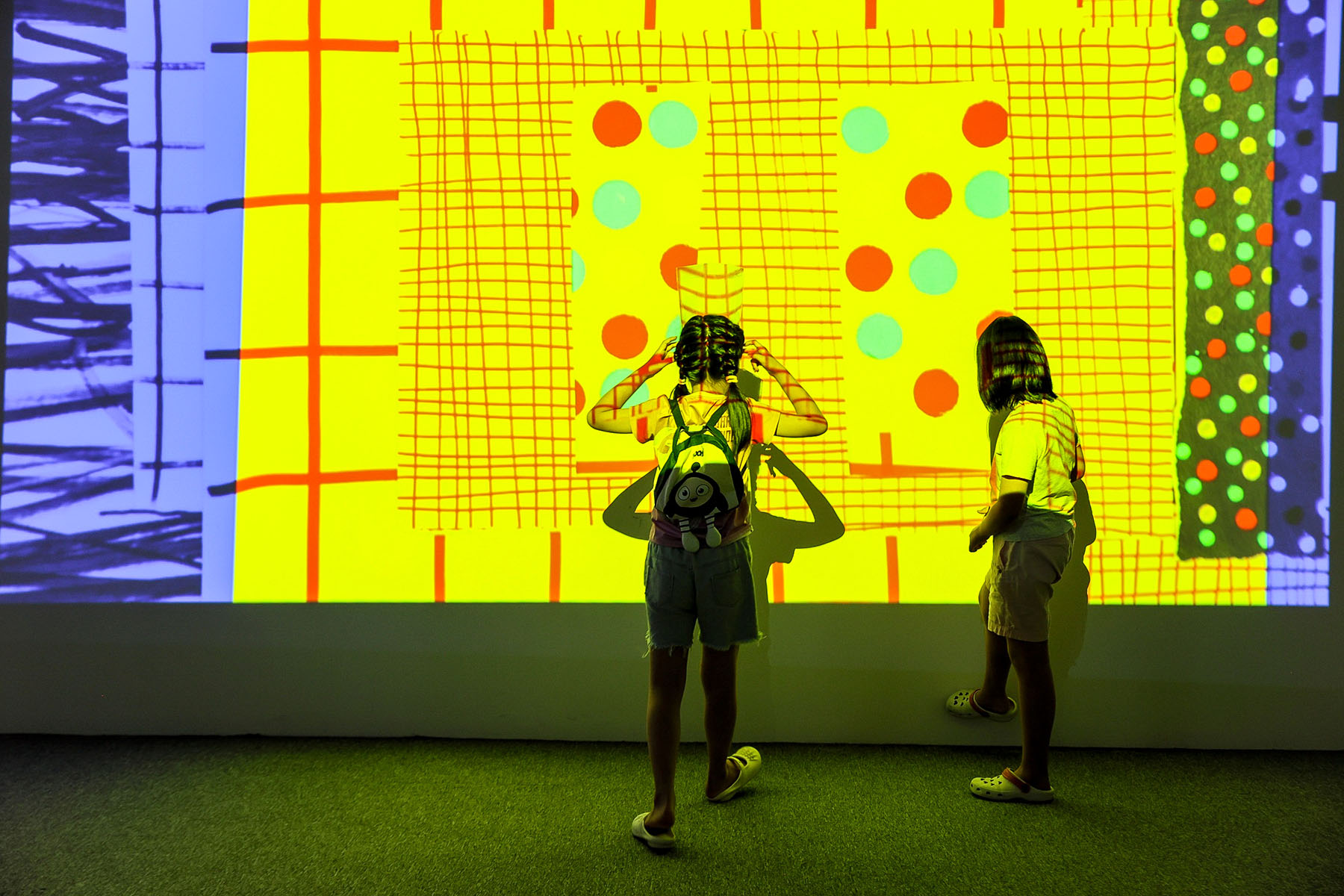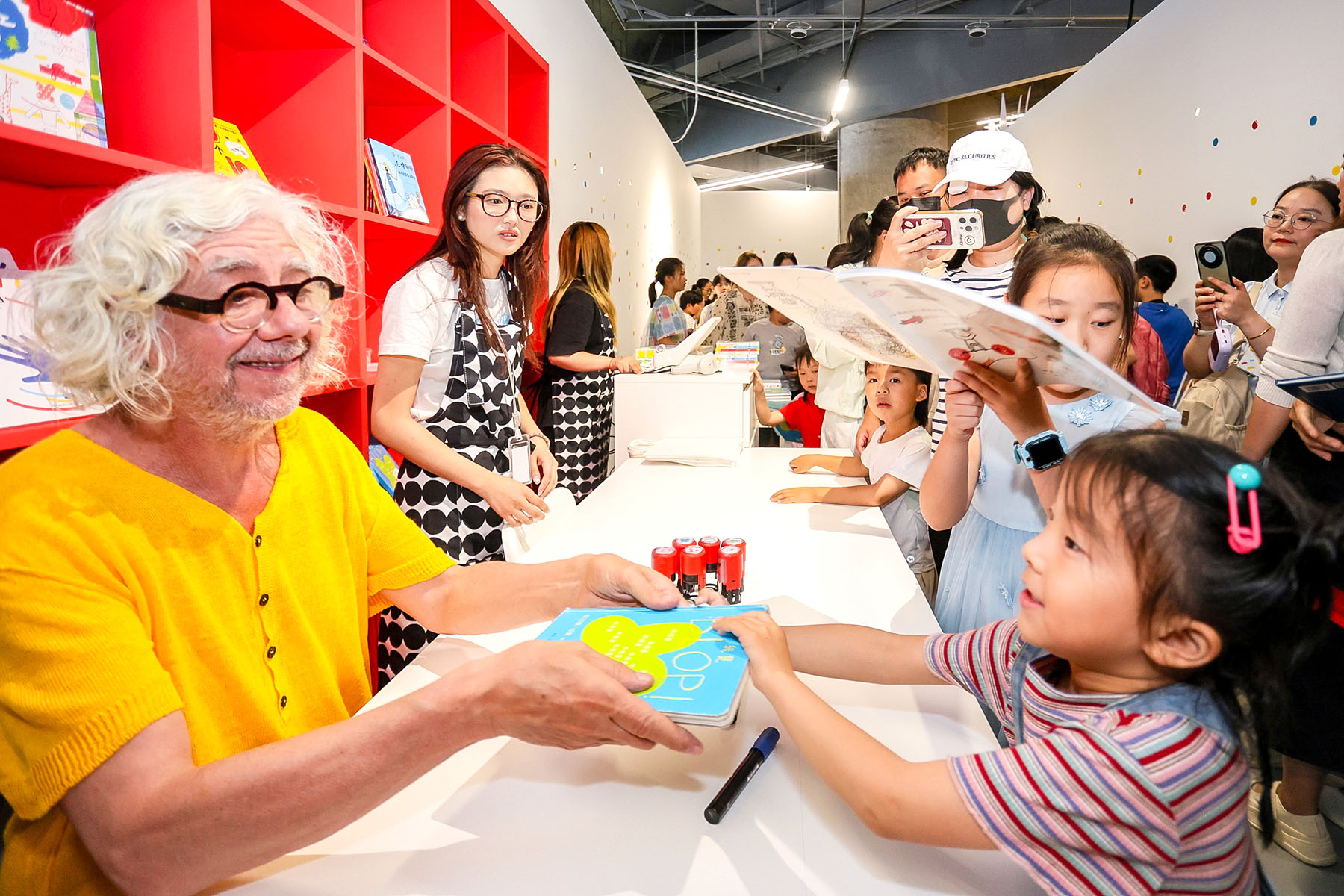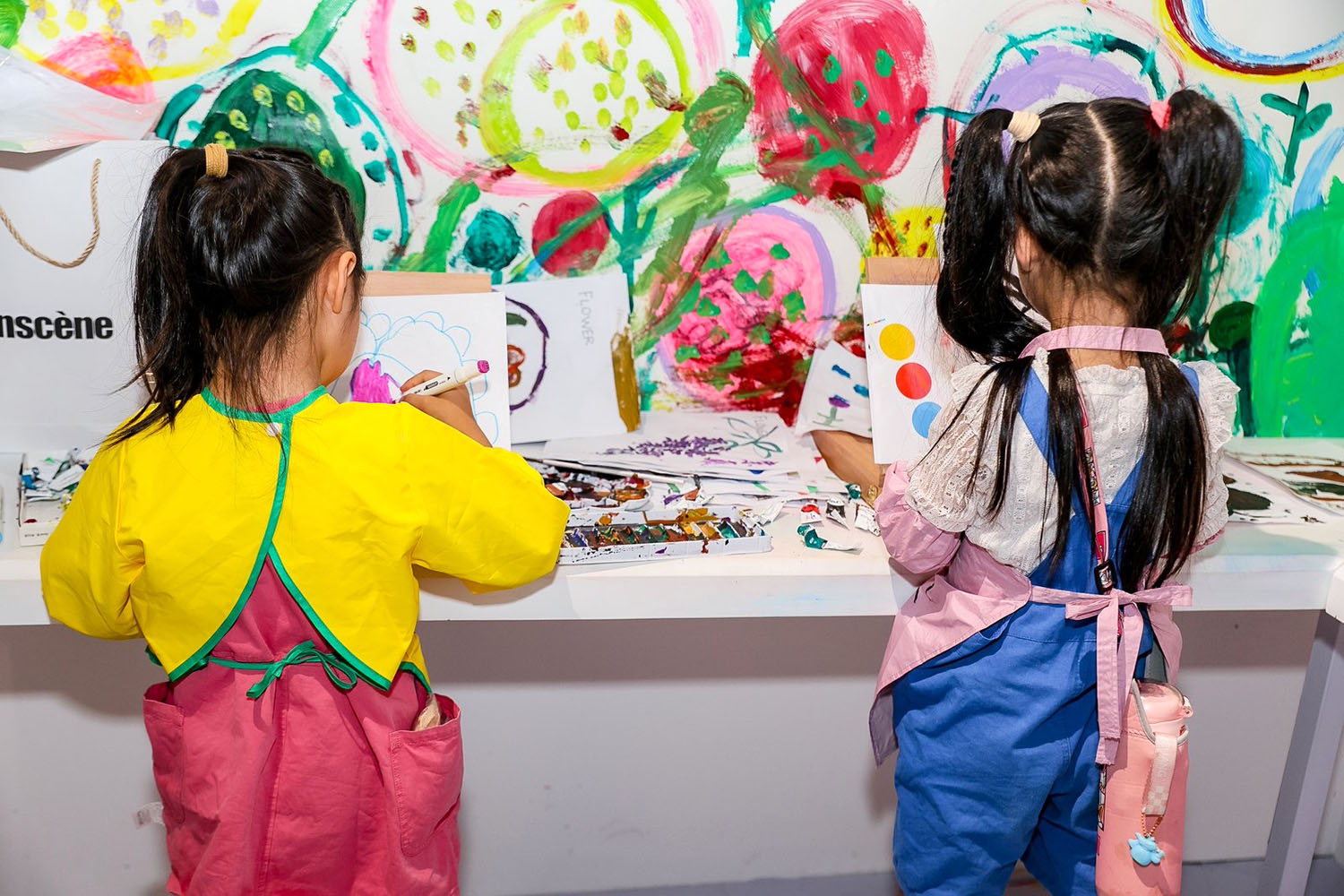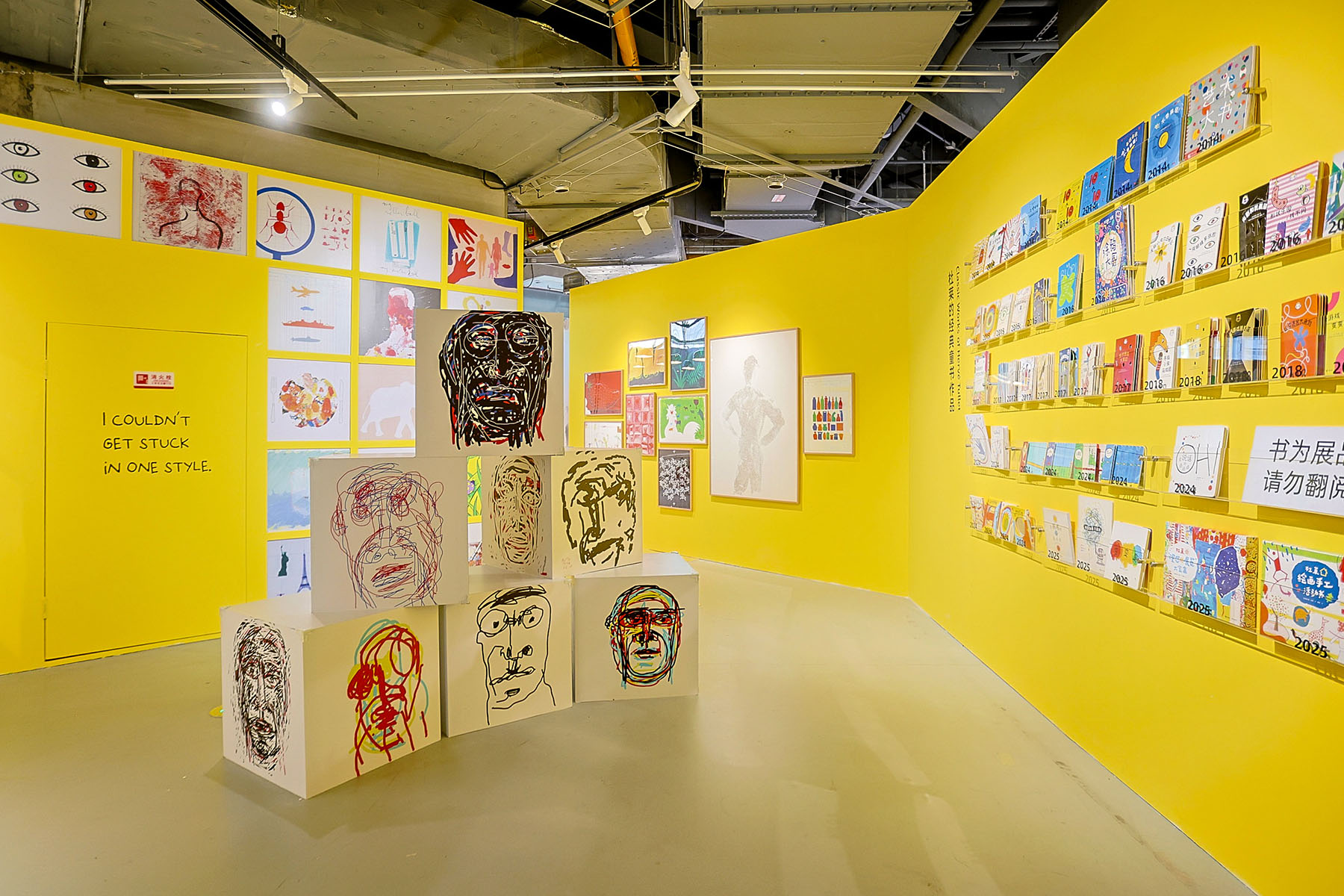Pioneering author creates immersive exhibition that reflects his interactions with children, Wang Qian reports.

Red, yellow and blue dots dance across walls as children's laughter echoes through a pool of sun-hued balls. This is not a dreamscape but a corner of French artist Herve Tullet's Scribble Playground exhibition in Beijing.
As part of the 2025 Croisements Festival, the exhibition opened on June 21 and serves as a cultural exchange initiative between China and France. The event welcomes visitors to scribble on walls, tear installations, and become co-creators in Tullet's world, turning gallery rules upside down.
Known as the prince of children's books with over 80 publications under his belt, the 67-year-old author's work has been translated into dozens of languages and are beloved by young readers around the world. This is the first time the Chinese mainland has been graced by Tullet's exhibition.
READ MORE: Two countries celebrate a drawing bridge
"My books and exhibitions emerge from interactions with children — they 'bring me to space', so to speak. Each encounter adds layers, making the exhibition a living archive. I'm thrilled to share this journey," Tullet tells China Daily in an exclusive interview.
Curator Bai Tang describes the exhibition as "a constellation of mini workshops" where interaction trumps observation. "Why can't suns be blue? Must lines stay straight?" are pondering questions Tullet asks, hanging at the entrance and setting the tone for creative rebellion.
This philosophy pulses through the exhibition hall where his iconic characters, including the mischievous Turlututu, shape-shifting blop, and playful dots and lines, transform into immersive playgrounds.

Drawn in an archetypal manner with a crowned head and a heart shaped like an eye, Turlututu is a character created by Tullet, who claims it is himself. The exhibition's Turlututu-themed section includes a pool of yellow balls that invite visitors to play with the character and unleash their imaginations.
Coming in many colors, blops are Tullet's unique visual language for exploring concepts such as numbers, colors, art and friendship. A blop is similar to a four-leaf clover, a flower, or a butterfly that can run wild through a colorful circus of abstract ideas.
Visitors can experience how Press Here dissolves language barriers like magic and makes dots "jump "across pages to sing and dance.
Tullet insists: "You don't read my books. You play them. You give them voice."
Looking back on the start of his career as a children's book illustrator after working in the advertising design industry, Tullet credits parenthood for his creative transition. "My first child's birth returned me to innocence."
His first children's title was released in 1994. Four years later, he was awarded the Non-Fiction Prize at the Bologna Children's Book Fair.
All of his books are designed as experiences. Each line, point and color is intended to capture the attention of young readers. He trusts children's intrinsic intuition and allows them to visualize and live literary universes with artistic narratives beyond words.
He says his creative process mirrors a fisherman's patience. "I wait for ideas to surface, then layer impressions like cast nets."
His notebooks, filled with "freshly painted" moments, eventually become books deliberately designed as open invitations.

For Tullet, his story doesn't end when you finish the book; it lives through the children's retelling.
"My work is perpetually in progress; once released, it expands organically. That's the beauty of sharing — it takes on new life through others," he adds.
Like his books, the exhibition is experimental, which extends beyond displays and billboards. People can step into a re-creation of Tullet's Parisian studio, complete with the discarded balls of sketches and street photography that fuel his process.
A highlight of the exhibition is a canvas painting of a paper runway rolled out, letting children plant a single dot before moving on to plant another. As numerous dots emerge, children grow their imagination gardens.
From Tullet's interactive books, like Mix It Up, art critic Shen Peng realizes that inspiration is not about looking down but seeing eye to eye, reflecting a respect for children's cognition and insight into human nature.
Mix It Up uses primary colors — red, yellow and blue — to guide children in discovering how combining two basic colors can create a new one. Children can dip their fingers, touch, and engage in games by turning and closing pages to enjoy reading.
"In today's world, where algorithmic thinking is prevalent and artificial intelligence transforms creativity, we need Tullet's primal awakening style more than ever," Shen says.

Facing the digital age, Tullet still values physical books and tries to answer the question: "What is a book?" through his 80-plus books.
"Books are fragile, just paper and turning pages," he says. "But in that simplicity, you find an entire world.
"We rushed to digitize children's literature, but physical books endure. Why? Because they demand presence: a child holding the pages and imagining worlds. My books aren't meant to be read passively — they must be played. You give them voice, motion, and life; this tactile intimacy can't be replicated by screens," the illustrator says.
Running through Aug 31, Scribble Playground proves Tullet's theory that every child is an artist with courage as the only tool.
Yang Shimeng from the Beijing Chaoyang Cultural Tourism Group, which co-organized the exhibition, says that the event is a cultural feast for children during summer vacation, inviting them into a highly creative world.
ALSO READ: Exhibition puts stage jewelry in the spotlight
With a large fan base in China, Tullet's books are popular among children, educators and parents because they are designed to encourage children to participate in the storytelling process through creative play and imagination.
At the exhibition's opening ceremony, Yin Fang, a self-described Tullet fan-dad, said the exhibition shows how to let children become artists through play.
It is also what Tullet tries to emphasize: "We must learn from children, not teach them, because they are humans, not future adults."
Tullet feels profoundly at home during his three-week visit to China. Seeing Chinese children interact with his books, their emotions palpable and their stories unfolding, he sees them grow as bridges, beyond language, between hearts and across cultures.
"I feel that these books are understood, and it's beautiful to be alive through the pages," Tullet says.
Contact the writer at wangqian@chinadaily.com.cn



